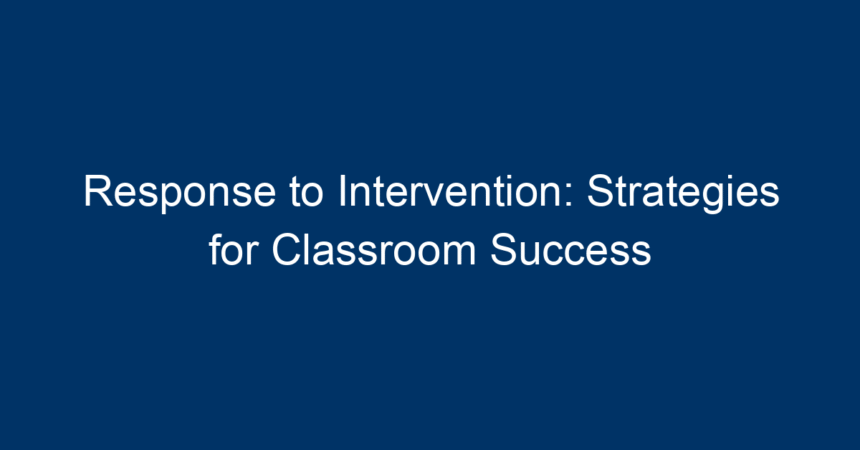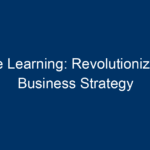In today’s diverse classroom environments, meeting the individual needs of each student can often feel overwhelming. Enter Response to Intervention (RTI) — a proactive approach that focuses on early identification and support for students requiring additional assistance. This comprehensive framework not only promotes academic success but also fosters a more inclusive learning environment. In this article, we’ll explore effective strategies for implementing RTI in the classroom, ensuring every student has the opportunity to thrive.
Understanding Response to Intervention
What is RTI?
Response to Intervention is a multi-tiered approach to early identification and support for students with learning and behavior needs. It integrates assessment and intervention within a school-wide, systematic framework to improve student outcomes. The goal is to provide timely support and modify instruction based on a student’s unique needs.
The Three Tiers of RTI
-
Tier 1: Universal Instruction
- In this initial tier, all students receive high-quality instruction in the general education classroom. Teacher-led instruction employs evidence-based teaching strategies. Regular assessments are conducted to monitor all students’ progress, providing a solid foundation for learning.
-
Tier 2: Targeted Interventions
- For students who struggle within Tier 1, targeted interventions are implemented. These may include small group instruction focusing on specific skills. Progress is closely monitored to ensure interventions are effective.
- Tier 3: Intensive Interventions
- Students who do not respond to Tier 2 interventions are provided with more intensive, individualized support. This may involve one-on-one instruction or specialized educational plans. Continuous assessment ensures that personalized strategies are adapting to the student’s needs.
Implementing RTI in the Classroom
Creating a Supportive Environment
Creating a conducive learning environment is crucial for successful RTI implementation. Here are some strategies:
- Build Trusting Relationships: Establish positive relationships with all students. A sense of belonging boosts engagement and motivation.
- Foster Collaborative Learning: Encourage students to work together. Peer tutoring can be an effective RTI strategy, promoting both social and academic skills.
- Cultivate Growth Mindset: Inspire students to embrace challenges and view failure as an opportunity for growth. This mindset is vital for students needing additional interventions.
Data-Driven Decision Making
Using data to inform instruction is a fundamental aspect of RTI. Here’s how to effectively incorporate data into your teaching practices:
- Regular Assessments: Conduct universal screenings at the beginning, middle, and end of the academic year to identify students needing support.
- Progress Monitoring: Utilize formative assessments to track student progress regularly. This ongoing data helps inform necessary adjustments in instruction.
- Collaborative Data Review: Engage in team meetings with educators to discuss data trends and share insights on individual student progress.
Effective Instructional Strategies
Differentiated Instruction
Differentiated instruction is a cornerstone of effective teaching within RTI. Here’s how to tailor learning experiences to meet the diverse needs of your students:
- Flexible Grouping: Use varying group arrangements based on skill level or specific learning objectives. This keeps students engaged and allows for targeted support.
- Varying Instruction Methods: Incorporate a variety of instructional strategies, such as direct instruction, cooperative learning, and hands-on activities, to cater to different learning styles.
- Adjusting Content: Differentiate content by providing modified assignments or varying complexity levels to accommodate individual student needs.
Evidence-Based Interventions
Implementing evidence-based interventions is critical in RTI:
- Research-backed Strategies: Select interventions supported by credible research. These may include programs focusing on literacy, numeracy, social skills, or behavioral interventions.
- Skill-Specific Focus: Target specific skills that students struggle with, ensuring that the intervention directly addresses their needs.
- Training and Support: Ensure that all staff are adequately trained in the interventions being used. This equips educators to effectively implement strategies and monitor student progress.
Roles and Responsibilities
Educators
Teachers play a vital role in the RTI process:
- Adapting Instruction: Use data-driven insights to modify teaching techniques based on student needs.
- Communication: Maintain open lines of communication with parents and caregivers about their child’s progress and any interventions being used.
Support Staff
Specialists and support staff enhance the RTI framework:
- Collaboration with Classroom Teachers: Work closely with teachers to identify students needing additional support and develop intervention strategies.
- Providing Additional Resources: Offer tools and materials that can enhance the learning experience for students facing challenges.
Administrators
School leaders provide the necessary support for RTI:
- Professional Development: Ensure ongoing training opportunities for educators to learn about RTI practices and effective interventions.
- Creating a Culture of Support: Promote an environment that values diverse learning needs and encourages collaboration among staff.
Involving Families
Family involvement is pivotal in the RTI process. Here’s how to foster engagement:
- Regular Updates: Keep families informed about their child’s progress and any interventions being employed. Regular communication builds trust and collaboration.
- Workshops and Resources: Provide parents with workshops on how to support their child’s learning at home, reinforcing strategies used in school.
Conclusion: Steps Toward Successful RTI Implementation
Implementing Response to Intervention requires a holistic approach involving educators, support staff, and families. Here are some actionable insights to strengthen your RTI framework:
- Embrace a Collaborative Culture: Foster teamwork among educators, specialists, and families to ensure comprehensive support for all students.
- Utilize Data Wisely: Regularly assess and adjust instruction based on student performance data to meet evolving needs.
- Stay Informed and Trained: Engage in continuous professional development to stay updated on effective strategies and interventions.
- Celebrate Successes: Acknowledge and celebrate small and large successes, motivating students to keep progressing.
By focusing on early intervention, tailored instruction, and fostering an inclusive environment, educators can ensure that every student has the opportunity to succeed. The Response to Intervention model is not just about addressing existing challenges; it’s about creating pathways for every learner to flourish.




